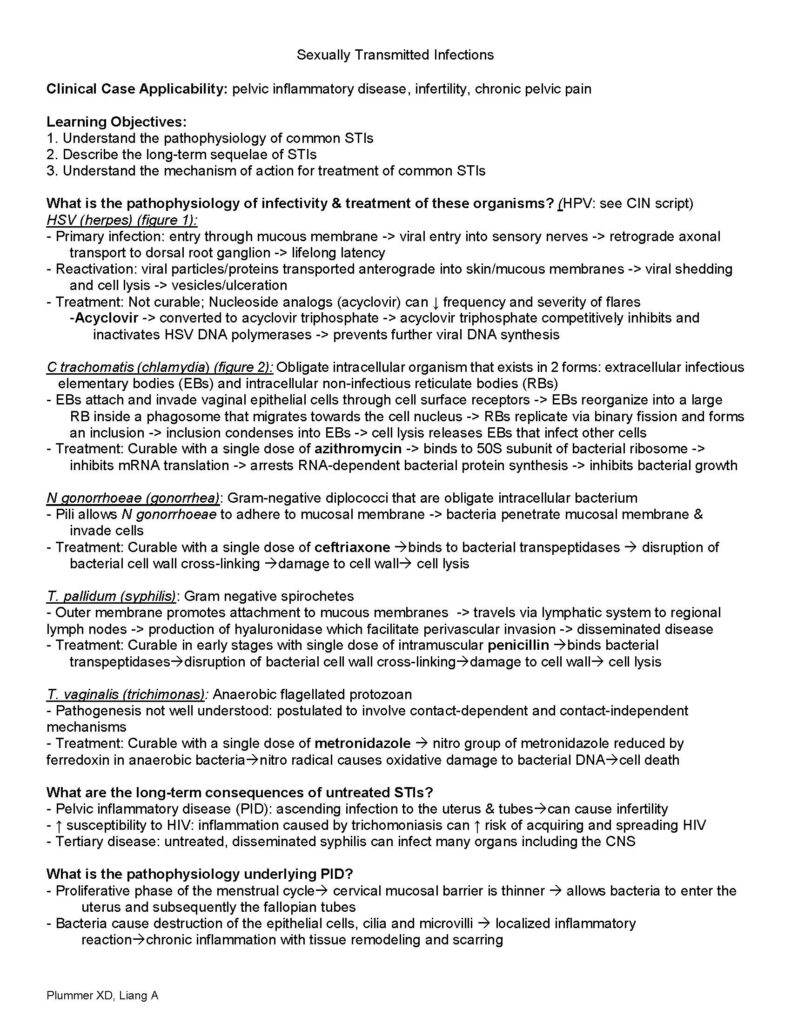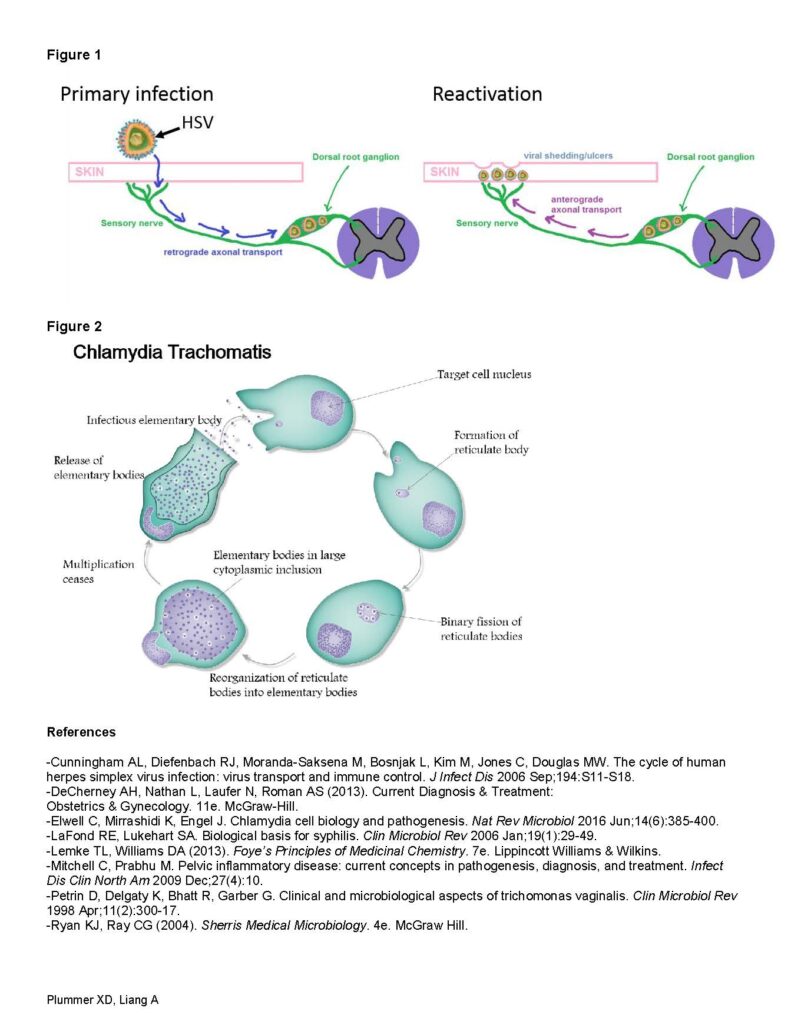Sexually Transmitted Infections
Duration 10:17
Sexually Transmitted Infections
Plummer XD, Liang A
Clinical Case Applicability: pelvic inflammatory disease, infertility, chronic pelvic pain
Learning Objectives:
1. Understand the pathophysiology of common STIs
2. Describe the long-term sequelae of STIs
3. Understand the mechanism of action for treatment of common STIs
What is the pathophysiology of infectivity & treatment of these organisms? (HPV: see CIN script)
HSV (herpes) (figure 1):
– Primary infection: entry through mucous membrane -> viral entry into sensory nerves -> retrograde axonal transport to dorsal root ganglion -> lifelong latency
– Reactivation: viral particles/proteins transported anterograde into skin/mucous membranes -> viral shedding and cell lysis -> vesicles/ulceration
– Treatment: Not curable; Nucleoside analogs (acyclovir) can ↓ frequency and severity of flares
–Acyclovir -> converted to acyclovir triphosphate -> acyclovir triphosphate competitively inhibits and inactivates HSV DNA polymerases -> prevents further viral DNA synthesis
C trachomatis (chlamydia) (figure 2): Obligate intracellular organism that exists in 2 forms: extracellular infectious elementary bodies (EBs) and intracellular non-infectious reticulate bodies (RBs)
– EBs attach and invade vaginal epithelial cells through cell surface receptors -> EBs reorganize into a large RB inside a phagosome that migrates towards the cell nucleus -> RBs replicate via binary fission and forms an inclusion -> inclusion condenses into EBs -> cell lysis releases EBs that infect other cells
– Treatment: Curable with a single dose of azithromycin -> binds to 50S subunit of bacterial ribosome -> inhibits mRNA translation -> arrests RNA-dependent bacterial protein synthesis -> inhibits bacterial growth
N gonorrhoeae (gonorrhea): Gram-negative diplococci that are obligate intracellular bacterium
– Pili allows N gonorrhoeae to adhere to mucosal membrane -> bacteria penetrate mucosal membrane & invade cells
– Treatment: Curable with a single dose of ceftriaxone binds to bacterial transpeptidases disruption of bacterial cell wall cross-linking damage to cell wall cell lysis
T. pallidum (syphilis): Gram negative spirochetes
– Outer membrane promotes attachment to mucous membranes -> travels via lymphatic system to regional lymph nodes -> production of hyaluronidase which facilitate perivascular invasion -> disseminated disease
– Treatment: Curable in early stages with single dose of intramuscular penicillin binds bacterial transpeptidasesdisruption of bacterial cell wall cross-linkingdamage to cell wall cell lysis
T. vaginalis (trichimonas): Anaerobic flagellated protozoan
– Pathogenesis not well understood: postulated to involve contact-dependent and contact-independent mechanisms
– Treatment: Curable with a single dose of metronidazole nitro group of metronidazole reduced by ferredoxin in anaerobic bacterianitro radical causes oxidative damage to bacterial DNAcell death
What are the long-term consequences of untreated STIs?
– Pelvic inflammatory disease (PID): ascending infection to the uterus & tubescan cause infertility
– ↑ susceptibility to HIV: inflammation caused by trichomoniasis can ↑ risk of acquiring and spreading HIV
– Tertiary disease: untreated, disseminated syphilis can infect many organs including the CNS
What is the pathophysiology underlying PID?
– Proliferative phase of the menstrual cycle cervical mucosal barrier is thinner allows bacteria to enter the uterus and subsequently the fallopian tubes
– Bacteria cause destruction of the epithelial cells, cilia and microvilli localized inflammatory reactionchronic inflammation with tissue remodeling and scarring Plummer XD, Liang A
Figure 1
Figure 2
References
-Cunningham AL, Diefenbach RJ, Moranda-Saksena M, Bosnjak L, Kim M, Jones C, Douglas MW. The cycle of human herpes simplex virus infection: virus transport and immune control. J Infect Dis 2006 Sep;194:S11-S18.
-DeCherney AH, Nathan L, Laufer N, Roman AS (2013). Current Diagnosis & Treatment:
Obstetrics & Gynecology. 11e. McGraw-Hill.
-Elwell C, Mirrashidi K, Engel J. Chlamydia cell biology and pathogenesis. Nat Rev Microbiol 2016 Jun;14(6):385-400.
-LaFond RE, Lukehart SA. Biological basis for syphilis. Clin Microbiol Rev 2006 Jan;19(1):29-49.
-Lemke TL, Williams DA (2013). Foye’s Principles of Medicinal Chemistry. 7e. Lippincott Williams & Wilkins.
-Mitchell C, Prabhu M. Pelvic inflammatory disease: current concepts in pathogenesis, diagnosis, and treatment. Infect Dis Clin North Am 2009 Dec;27(4):10.
-Petrin D, Delgaty K, Bhatt R, Garber G. Clinical and microbiological aspects of trichomonas vaginalis. Clin Microbiol Rev 1998 Apr;11(2):300-17.
-Ryan KJ, Ray CG (2004). Sherris Medical Microbiology. 4e. McGraw Hill.


